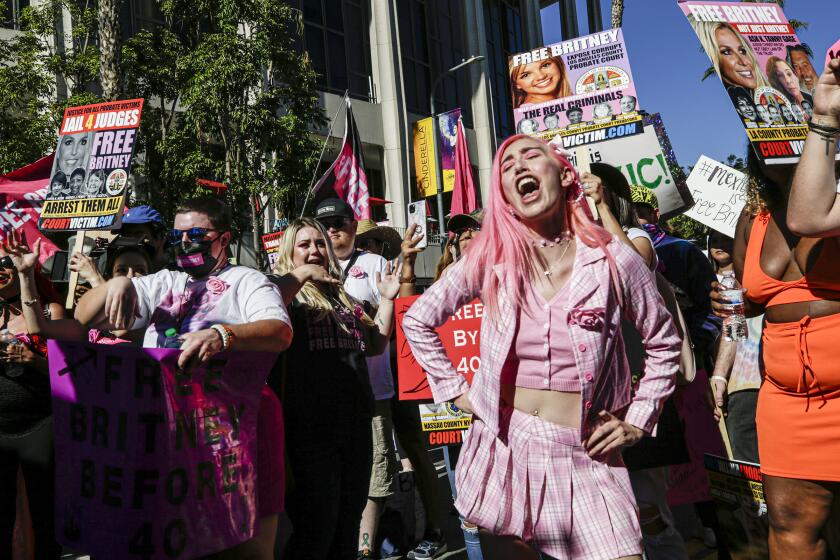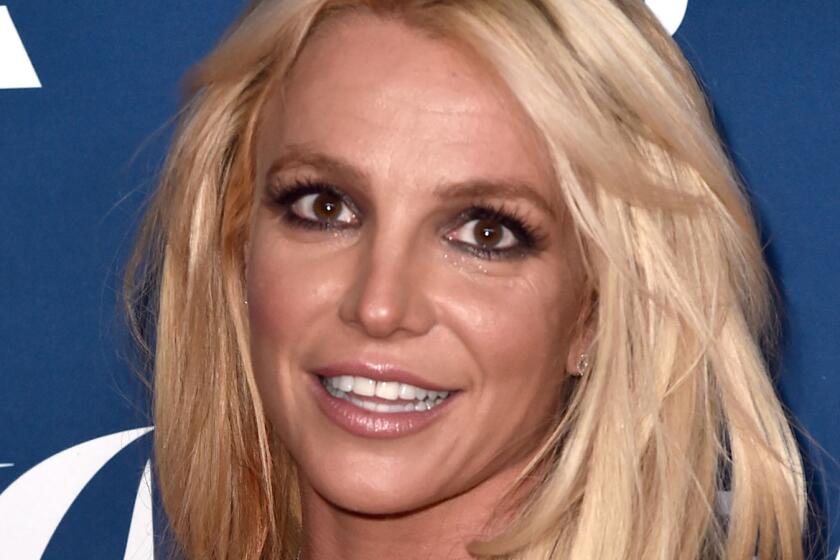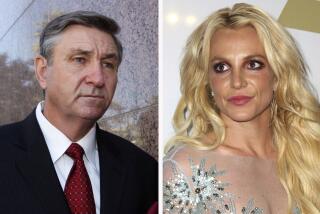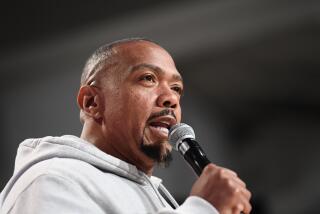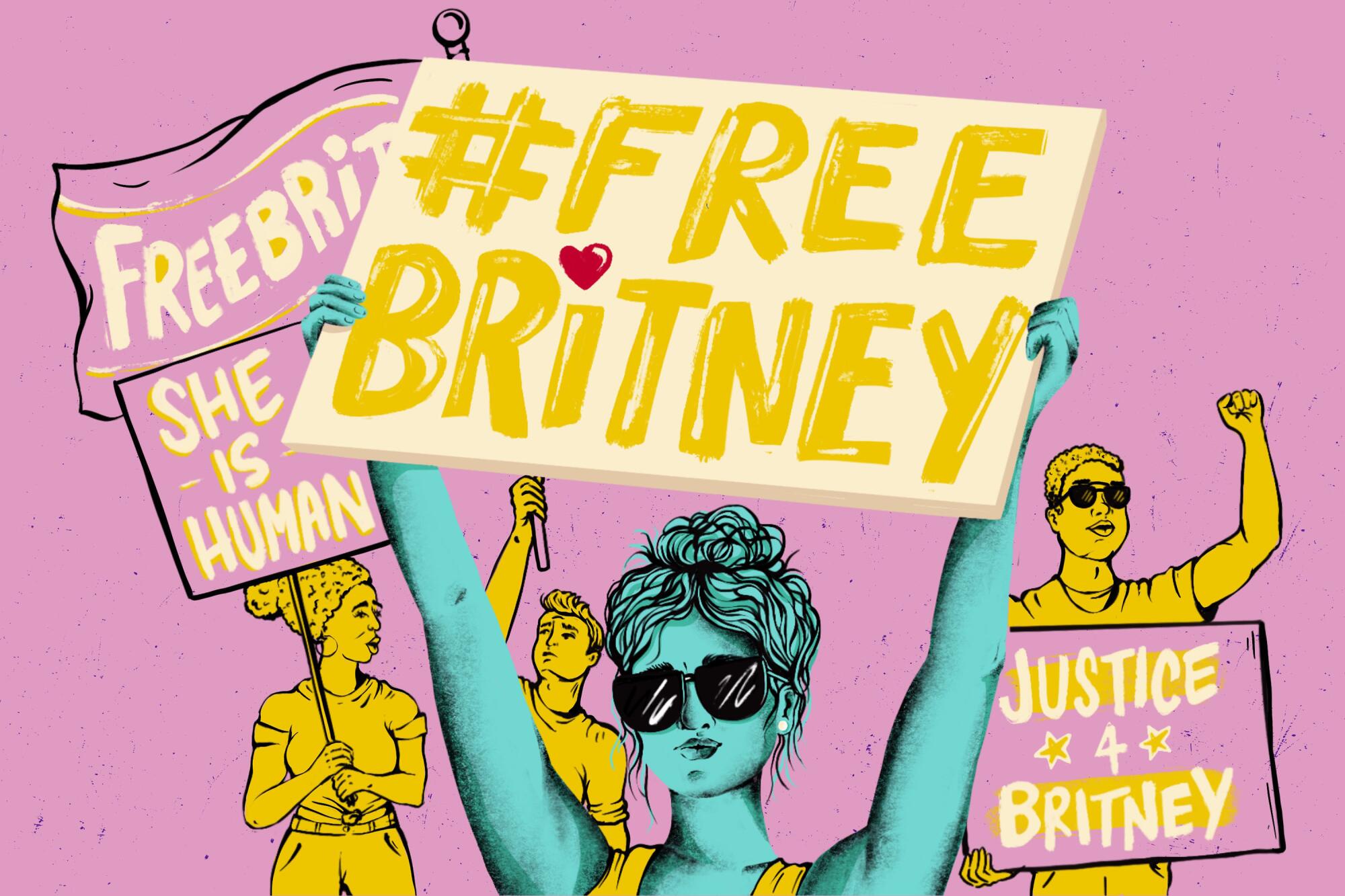
They’re out there in plain sight — teachers, data analysts, bank tellers, students, psychologists, dance instructors, podcast hosts, baristas, digital marketing managers. They’ve united in recent months and even years over the internet, and sometimes in packs outside a Los Angeles court building, for a common mission: to help Britney Spears, one of pop music’s most iconic stars, regain autonomy over her life.
The grassroots campaign, commonly referred to as the #FreeBritney movement, goes beyond that of most music fandoms, which typically mobilize for more prosaic reasons, such as pushing their idol’s new record to the top of the charts. Britney’s fan army has an altogether weightier goal: to shine a light on and shape the conversation around the 39-year-old singer’s fraught 13-year conservatorship.
Spears’ activist supporters show up at hearings poised for battle, marching with banners and propping up pink signs with phrases like “Britney Spears is a human being” or “Not a Girl, Not Yet a Free Woman” on sidewalks outside the courtroom. They pore over legal documents, host Instagram Lives, make TikTok explainer videos, compose Twitter threads and upload YouTube videos, in a variety of languages, seeking justice, in their eyes, for Spears.
Britney Spears is finally free.
The singer’s father, Jamie Spears, who has long come under fire by #FreeBritney for his role as conservator of her estate, has derided the movement, while Britney herself (or whoever has oversight of her Instagram account) has used the #FreeBritney hashtag and publicly recognized the movement as recently as a few weeks ago.
And while the ardent group of fans have been laughed at for their unwavering efforts to help a singer they know only from a distance, their advocacy appears to be paying off.
During a June hearing, Spears delivered bombshell testimony in which she called the conservatorship “abusive” and voiced her desire to sue her family. The emotional public statement, in stark contrast to Spears’ oft-benign social media postings, gave credence to years of public speculation by #FreeBritney advocates that Spears had been muzzled by her family and wanted to be free of the conservatorship.
Subscribers get early access to this story
We’re offering L.A. Times subscribers first access to our best journalism. Thank you for your support.
“She was voiceless for a long time,” says Megan Radford, an organizer with Free Britney L.A. “We are really grateful that we’ve come this far.”
When headlines hit in August that Jamie Spears would step down from his position — less than a month after the singer’s new attorney, Mathew Rosengart, had petitioned the court for his removal — some members of #FreeBritney saw victory in sight. Now, after previously offering only a vague timeline for his departure, and being accused by Rosengart of trying to “extort” roughly $2 million from his daughter’s conservatorship, Jamie Spears filed a new petition Sept. 7 to end the 13-year conservatorship for good.
An L.A. judge ruled Friday to terminate Britney Spears’ controversial conservatorship. These stories explain the long and complicated history behind it.
The next court hearing in Spears’ case had already been scheduled for Sept. 29 — and throngs of supporters are again expected to gather outside the L.A. courthouse.
This is the story of how #FreeBritney grew beyond a catchy tagline in an online fan posting into a bona fide global movement that just might achieve its dream of freeing Britney Jean Spears.
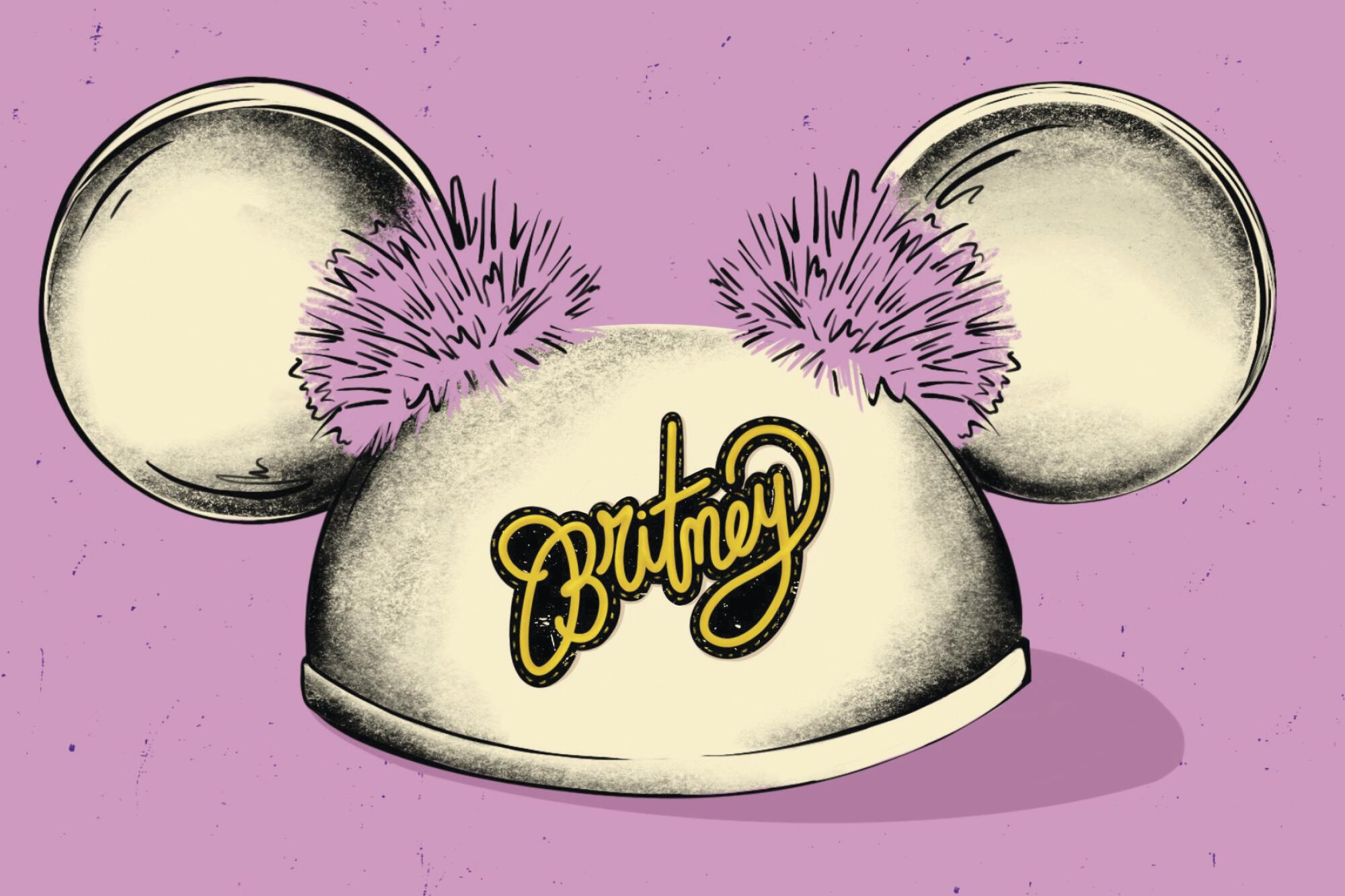
1. ‘She had that star quality’
At the tender age of 16, “The Mickey Mouse Club” alumna from Kentwood, La., catapulted into fame alongside fellow teen-pop pin-ups Backstreet Boys and ‘N Sync with her debut album’s first single “ ... Baby One More Time” and its now-iconic music video.
Jordan Miller (founder of BreatheHeavy.com, a Britney Spears fan site): I saw the CD at Borders [a former book and music retailer]. I picked it up and flipped the CD over. I remember seeing a song called “Soda Pop” and the rest is history.
Tess Barker (co-host, “Britney’s Gram” and “Toxic: The Britney Spears Story” podcasts): I was introduced to her on MTV’s “TRL” [“Total Request Live”]. She had that star quality. I was coming off of the Spice Girls era so I was looking for a new diva in my life.
Kevin Wu (Free Britney LA organizer/manager of FreeBritney.army website): I was 14 when I heard “... Baby One More Time” on the car radio. I fell in love immediately.
Junior Olivas (Free Britney LA organizer/manager of FreeBritney.army website): I was 11 and my uncle was living with us. I heard “...Baby One More Time” from his room and I was like, “Oh my God, what is that?” Her music video was on his TV. I never looked back.
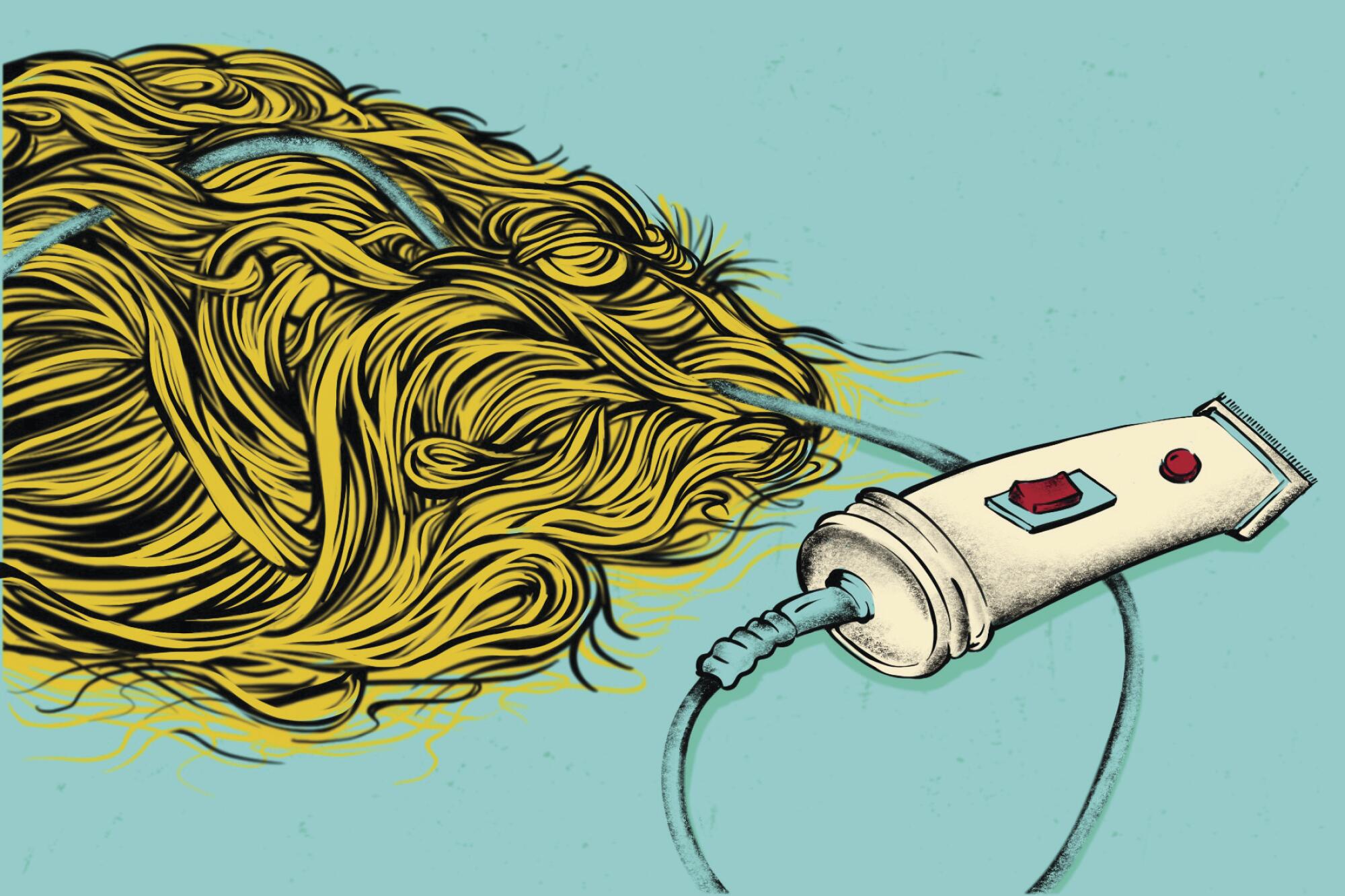
2. ‘Every table was talking about it’
Spears’ carefully constructed image as the virginal girl next door began to unravel as her romantic life made her a tabloid fixture in the early aughts. Her relationship with ‘N Sync’s Justin Timberlake ended in 2002, as rumors of Spears’ infidelity stoked slut-shaming headlines. In 2004, she wed childhood friend Jason Alexander in Las Vegas — the marriage was annulled 55 hours later. A few months later, she married backup dancer Kevin Federline. They have two sons, Sean Preston and Jayden James.
Spears’ marriage troubles, mothering practices, alleged substance abuse issues and mental health challenges received wall-to-wall tabloid coverage. In February 2007, Spears shocked the world when she marched into a Tarzana beauty salon, grabbed a pair of clippers and buzzed her hair off in front of a parade of paparazzi. Days later, she hit a photographer’s car with an umbrella.
Welcome, latecomers to Britney Spears’ conservatorship battle (and experts who want to test their wits). This Q&A will tell you all you need to know.
Barker: I was a cocktail waitress at [Hollywood’s] Cat & Fiddle. Every table was talking about it. But right off the bat, I was never confused about why she shaved her head. I was like, “Yeah, of course, she did.”
Barbara Gray (co-host, “Britney’s Gram” and “Toxic: The Britney Spears Story”): I remember it from the tabloids — that narrative of “Oh, she went crazy.”
Jaclyn (co-host of “Eat, Pray, Britney” podcast; last name withheld upon request): Her behavior was positioned as being outrageous and crazy, when it so clearly seemed to be a rejection of the iconography of Britney Spears. There was a fear that something awful could potentially happen. It seemed like there was constant chaos.
The saga prompted concern among fans — and memorably inspired the emotional “Leave Britney Alone!” video from Cara Cunningham, then 19. The video went viral and mostly became a target of ridicule and satire.

Meanwhile, Spears’ public struggles came to a head in January 2008 when she was placed on two separate involuntary 5150 holds, at Cedars-Sinai Medical Center and UCLA Medical Center. The 26-year-old was later placed in a court-ordered conservatorship, temporary at first, that gave her father Jamie Spears and the lawyer Andrew Wallet oversight of her medical care, finances and day-to-day activities. Fans started keeping close tabs on the singer’s situation. In the MTV documentary “Britney Spears: For the Record,” released in November 2008, Britney became emotional discussing her circumstances: “If I wasn’t under the restraints I’m under right now, with all the lawyers and doctors and people analyzing me every day — if that wasn’t there, I’d feel so liberated,” she said.
Miller: I was immediately questioning the conservatorship. My posts were angry; I didn’t have a filter — I was 19. I wrote a post [in December 2008] with the headline: “Prisoner Forbidden Phone Privileges.” It detailed allegations [reported by other outlets] that Britney was unable to have access to a cell phone and that Jamie Spears was receiving a raise — $16,000-plus a month from something like $10,000. I was outraged and wrote something like: How can she be on tour, put out music, do interviews and be deemed incompetent by the courts? Then I signed off with “Free Britney” in a big font. In other posts I wrote throughout the next few months, I kept saying it: “Free Britney, Free Britney.”
Wu: Any Britney fan knew that she and her dad didn’t have a good relationship. But at the same time, I didn’t understand what a conservatorship was. Her team did a really good job of pushing the narrative that the conservatorship was good for Britney, and the right thing for us fans to do was to keep buying her albums and seeing her concerts.
In 2009, Spears set out on her “Circus” tour, which was followed by the 2011 album release and tour for “Femme Fatale.” By 2012, she was cast as one of the four judges on “The X-Factor.” A year later, Spears began her “Britney: Piece of Me” residency in Las Vegas — her father later asked for, and was granted by the court, compensation from the residency, on top of the pay he already received for managing her estate.
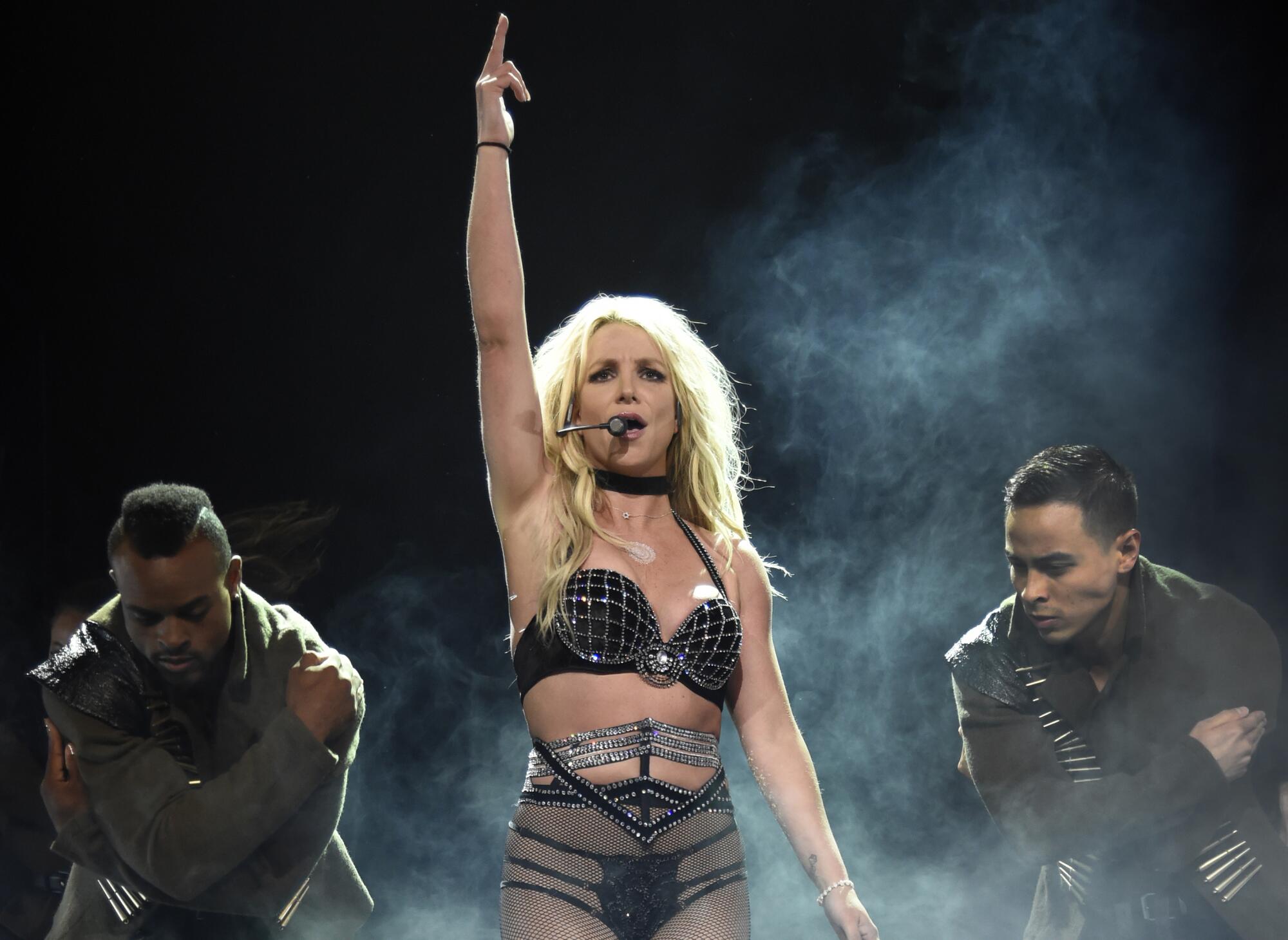
Radford: In 2009, I wore a Free Britney T-shirt and had this, like, one-woman rally outside Britney’s “Circus” concert in Dallas. And then I went to the concert! It didn’t compute that I was contributing to the issue.
Barker: The “Circus” album was lit, the tour was lit. She did an episode of “How I Met Your Mother.” I thought she was crushing it.
Olivas: I started to notice that something was wrong when Britney went on the “Piece of Me” tour in 2018. You would read reports from people on message boards about their experiences at the meet-and-greets. There was the sense that Britney did not want to be there, that things seemed off.
Wu: There was this one fan, named Marta, who has a very well-known story on BreatheHeavy.com — she had a really bad meet-and-greet with Britney. She recorded a video and posted it to YouTube right away. That made the rounds.
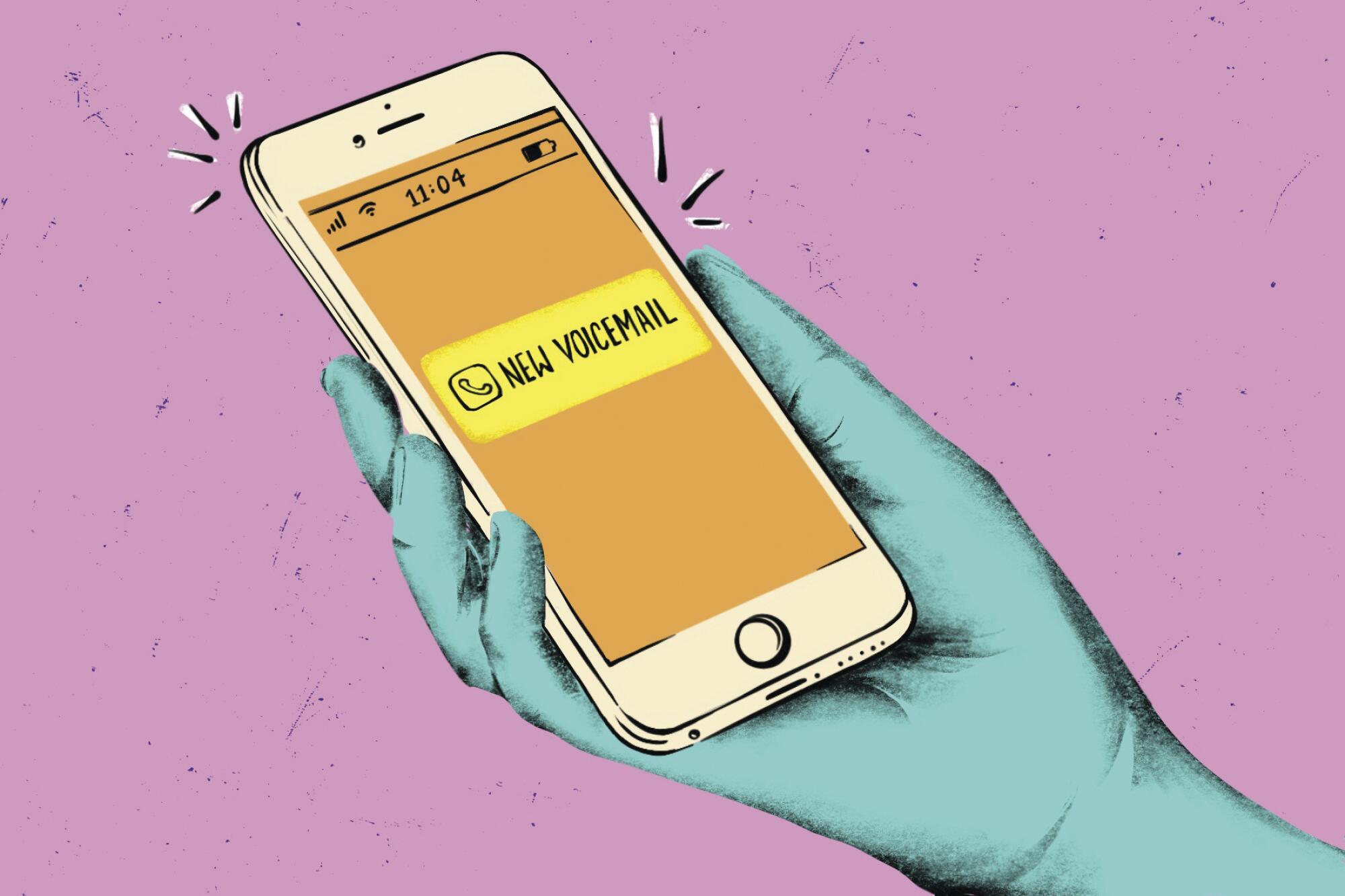
3. ‘That’s when I joined the movement’
By 2018, plans were announced for a second Las Vegas residency called “Domination,” but a month before it was set to begin, the shows were canceled. Not long after, Wallet, the co-conservator on her case, submitted his resignation. And after a three-month hiatus from social media — the singer’s Instagram feed up to that point had largely consisted of inspirational quotes, the occasional workout video, stock images of flowers or animals and glimpses of her doing things like painting on her veranda — Spears returned to Instagram with a post about needing “me time.”
Barker and Gray, whose “Britney’s Gram” podcast initially functioned as a humorous analysis of Spears’ Instagram postings, found the caption, which included an emoticon smiley face instead of her usual string of emojis, out of character for the singer. Not long after that, reports surfaced that Spears checked herself into a mental health facility. The following day, an anonymous source left a voicemail in the Google Voice inbox they set up for their podcast. The person, who requested anonymity, claimed to be a former paralegal for a lawyer who worked on Spears’ conservatorship. He alleged that Spears entered the facility against her will and that her father pulled the plug on the residency because of his daughter’s unwillingness to take her medication as prescribed.
Tess Barker and Babs Gray go from courtroom to podcasting mics to report their new ‘Toxic’ deep-dive look into Britney Spears’ conservatorship case.
Barker: I listened to that voicemail and my whole world changed. I understood the gravity of it just from the way the guy’s voice sounded. It felt like this confluence of all our suspicions. Babs was in Austin doing standup, and I called her right away.
Gray: I came home a day early just to figure out what we should do. We went from being people who were kind of analyzing the situation to people who had to make a decision about whether to actively become involved in it.
Barker: We started texting with the source. We had him send us proof of his employment.
Gray: We released the episode [titled “#FREEBRITNEY”] in the middle of the night [on April 16, 2019], so that it could make the rounds before we’d be asked to take it down. We were terrified that we were gonna get sued.
Radford: It was just like, holy crap, everything we ever thought was right, we’ve got to do something.
Wu: That’s when I joined the movement.
Olivas: As soon as the voicemail dropped, I jumped into action. I never had been to a rally in my life, but it was something I had to do.
Wu: Junior and I met at a rally and we stayed in touch. I don’t think we would have predicted that we would still be in this fight two years later.
Radford: That first rally that I went to, not only did I not have to explain my love for Britney, but I didn’t have to explain what #FreeBritney was or why it mattered so much to me. It was one of the best days of my life. Meeting Junior and Kevin and other advocates — these people are some of my best friends. We’ve been through a lot together.
Pilar Vigneaux (#FreeBritney advocate based in Chile): Sometimes people in my life will be like, “You’re talking about Britney Spears again; you’re working to help someone you’ve never met.” This is more than Britney. This is a matter of human rights. And if this can happen to Britney, a powerful woman in the public eye, imagine an older person or people who have no support network?
Leanne Simmons (Free Britney LA organizer/manager of FreeBritney.army website): People would call me crazy. And worse than that, they would say, “Oh, but [Britney’s] crazy.” And it’s like, OK, but this is a violation of human rights. Also, what is crazy? That’s such a subjective term.
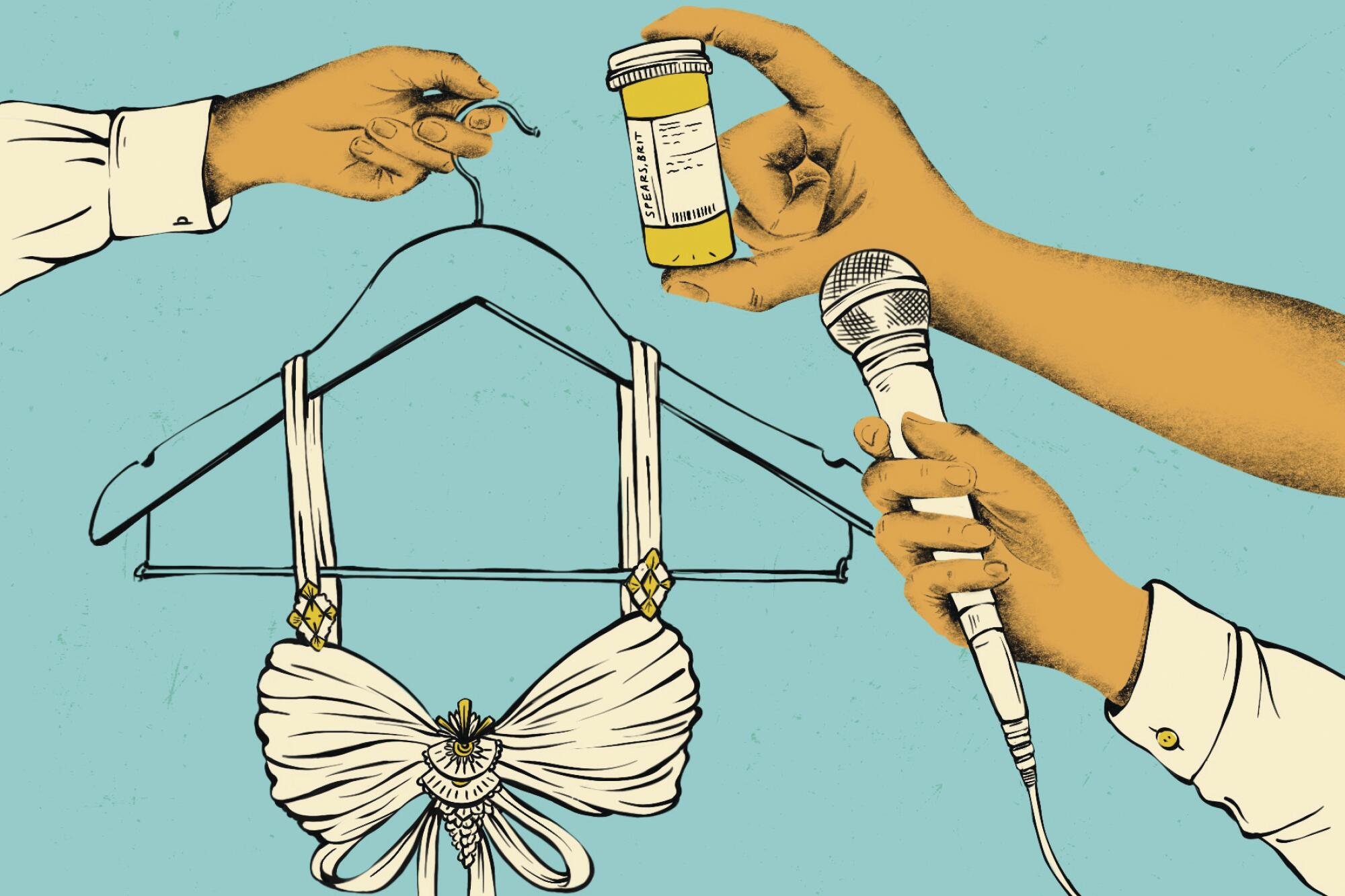
4. ‘The tipping point’
As TikTok’s popularity exploded in 2020, #FreeBritney clips proliferated on the platform: One Zapruder-type analysis of a single Spears social-media post, by Mars Monroe (a.k.a. @moonwalkmars), received 13.2 million views. But #FreeBritney gained its greatest visibility when it, along with some of its supporters, was featured in “Framing Britney Spears,” part of “The New York Times Presents” documentary series on FX in February 2021. The buzzed-about two-hour film traced the pop singer’s rise to fame, the tours and concerts under her minders’ watchful eyes and the questions surrounding her conservatorship.
Samantha Stark (director, “Framing Britney Spears”): I didn’t know that much about Britney Spears. And I did this survey of people I knew and asked: “What comes to mind when you think of Britney Spears?” And so many people said “when she shaved her head.” I found that ridiculous and sad. It made me want to know why people love her, so I started talking to her fans. They were protesting outside the courthouse because of the mysterious conservatorship she was in. They were so worried when I started talking to them — like, “Please don’t portray us as conspiracy theorists, everybody does.” People would say, “Oh, these crazy fans look at her Instagram and think she’s saying ‘help’ with her eyelashes or that she’s wearing yellow to show that she needs help.” But when I talked to them, they brought up these important questions about the conservatorship system.
Gray: We thought that the documentary would help legitimize the movement. I did not expect it to get as big as it did.
Olivas: When the documentary came out, things skyrocketed, and it was almost impossible for one person to manage the [FreeBritney.Army] account. It was so much, so fast.
Jaclyn: The documentary was the tipping point the movement had been waiting for.
Following the documentary’s release, celebrities including Cher, Bette Midler, Miley Cyrus, Kacey Musgraves and Courtney Love joined the #FreeBritney chorus with social media postings and public displays that voiced their support for Spears.
Vigneaux: [With #FreeBritney], there’s before and after that documentary.
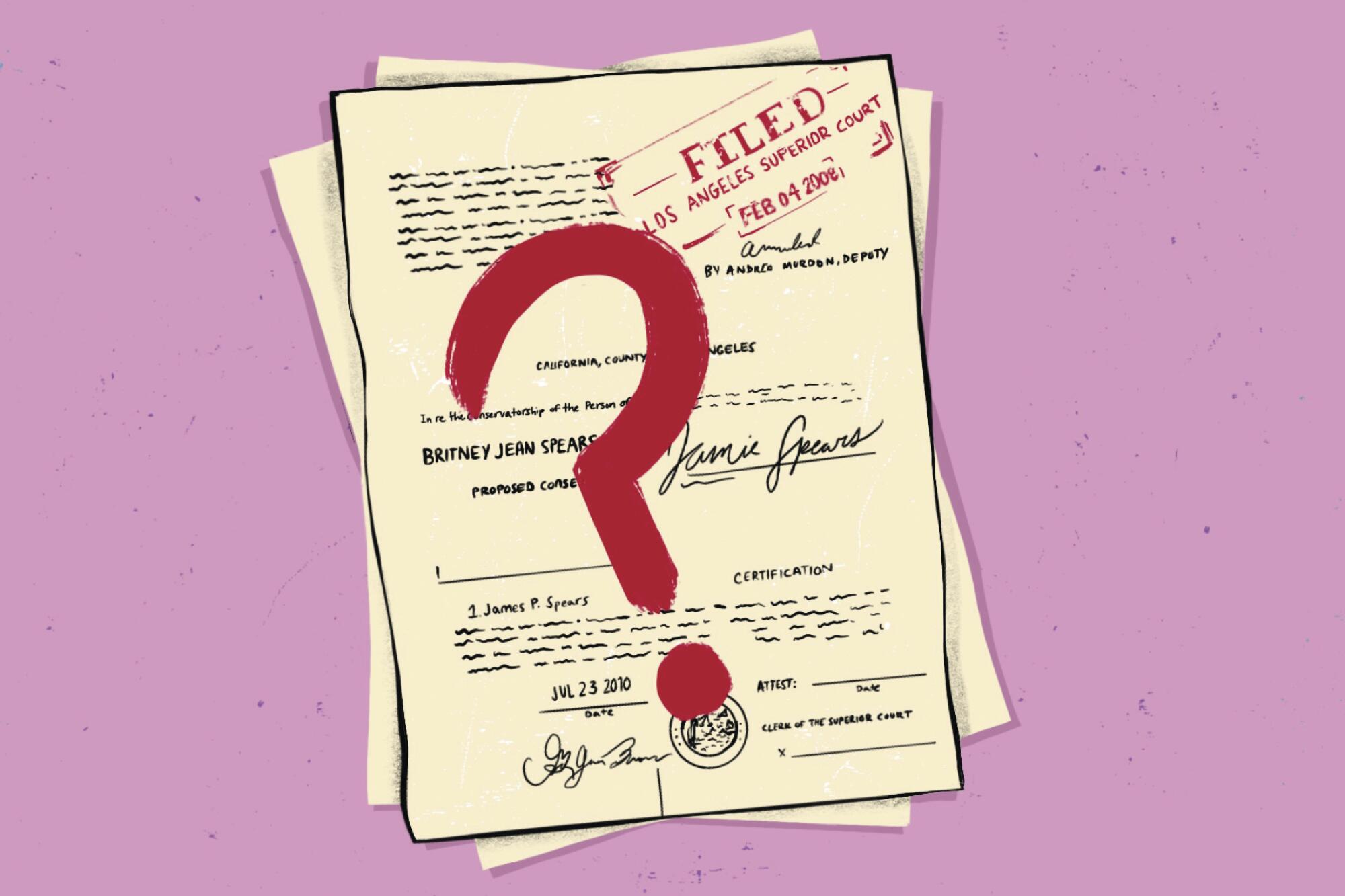
5. ‘It was just wild. And heartbreaking’
On June 23, 2021, Spears addressed the court remotely about her conservatorship arrangement, requesting the call be open for the press to hear. In her emotional and blistering 23-minute statement, the singer said she desperately wanted to terminate her conservatorship, describing it as an abusive system in which she was drugged, pressured to work against her will and denied the ability to have her IUD removed. It was a flashpoint in the #FreeBritney movement, with her testimony confirming the worst suspicions of her devoted fans.
Miller: I was right here in my little office [in Las Vegas], on Exhale [a message board within BreatheHeavy.com where fans can interact], refreshing the thread — there was 20 replies every 10 seconds. As Britney was saying everything, fans were commenting about what they’re experiencing. It was bittersweet. You’re listening to terrible, awful happenings that have taken place, but at the same time, I felt like I was a part of this community — we were all together in this moment.
Barker: I went in [to the courtroom] with Samantha Stark from “Framing Britney Spears.” They allowed very few reporters and they were really strict about showing your credentials. It was really empty and quiet inside and there were special deputies surrounding the building. It was this really tense, high-stakes moment. And when Britney interrupted the attorney and said she wanted to keep the courtroom open, it felt like I’d had the wind knocked out of me, like I was watching the moon landing or something.
When Tess Barker and Barbara Gray created their podcast about Britney Spears’ Instagram account, they “didn’t understand the gravity of the situation.” Not anymore.
Gray: I was outside with a bunch of the #FreeBritney organizers and people I’ve seen dozens of times at these hearings. There was only one phone and we were all crouched around it trying to listen. At some point, they plugged it into a loudspeaker, and then you could hear Britney’s voice saying she wanted to hire her own lawyer. It was like being at the Super Bowl. It was just wild. And heartbreaking.
Lisa (co-host of “Eat, Pray, Britney” podcast; last name withheld upon request): It was devastating to hear what she described; it was brutal. We suspected some of it. But to have her say it in her own words was hard to hear.
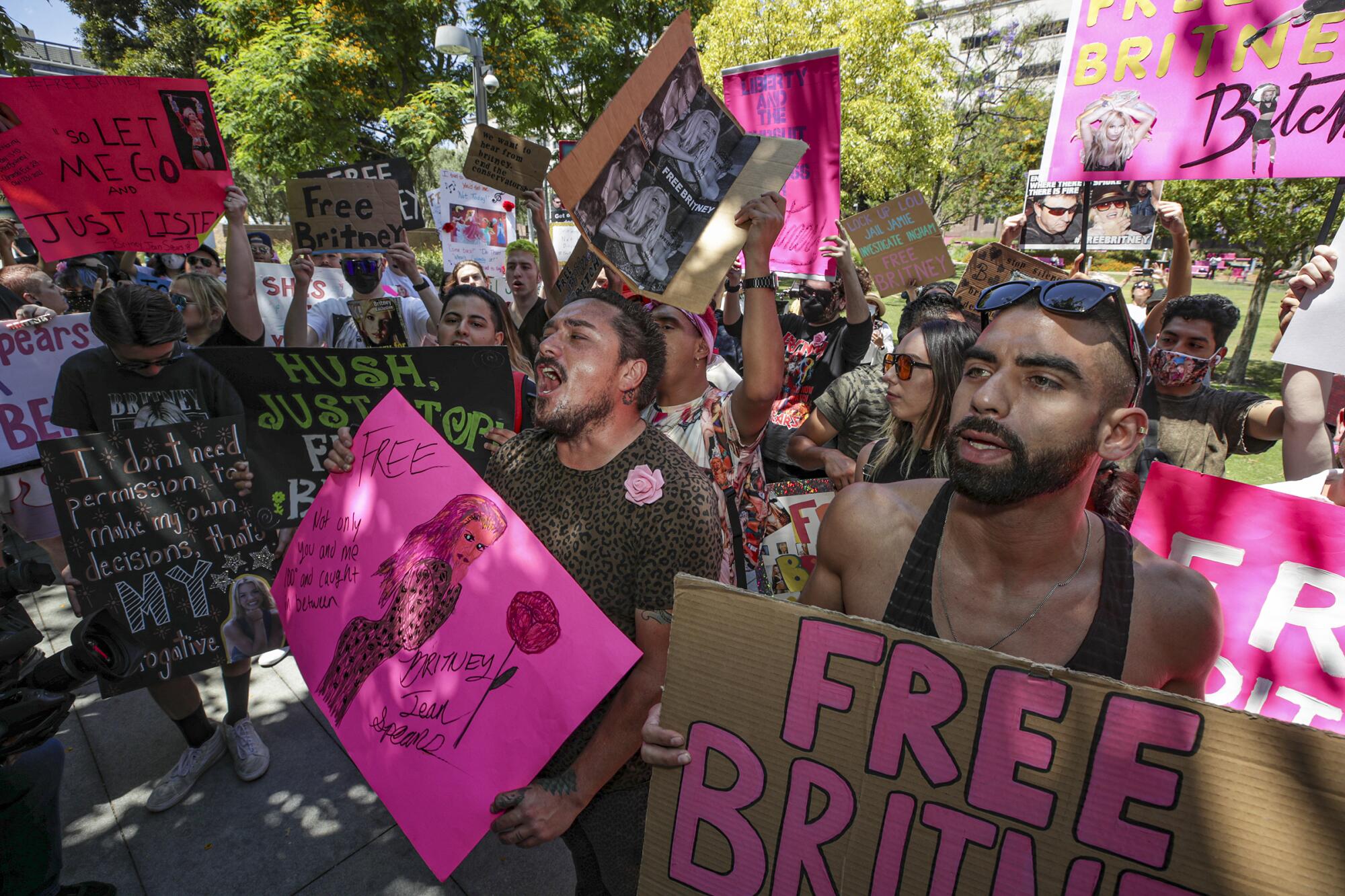
Spears’ bombshell testimony triggered a series of departures — her longtime court-appointed lawyer, Samuel D. Ingham III, asked to resign, as did a wealth management firm that was set to share control of Spears’ estate with her father. Multiple court filings also followed.
At the first hearing following Spears’ testimony, Judge Brenda Penny ruled in favor of allowing the singer to hire her own personal attorney. Spears hired former federal prosecutor Mathew Rosengart, who quickly petitioned the court to replace Jamie as the singer’s conservator, calling her father’s broad control of her career and fortune “traumatizing, insane and depressing.”
In the wake of Spears’ testimony, her case caught the attention of some political figures. Rep. Matt Gaetz, the Republican congressman from Florida who is currently under investigation for allegations of sex trafficking and sex with a minor, attended a #FreeBritney rally outside Stanley Mosk Courthouse in mid-July, calling Spears’s father a “grifter.” Some #FreeBritney advocates have questioned whether Gaetz is exploiting the movement.
Jaclyn: We definitely don’t support any political figure that is a participant or a supporter of any white supremacist ideology. And we definitely don’t support any of their appearances at any of these events.
Elsewhere, two members of the House of Representatives — South Carolina Rep. Nancy Mace and Florida Rep. Charlie Crist — proposed a bipartisan bill that aims to protect Spears and other individuals under legal conservatorships or guardianships. The legislation is known as the Freedom and Right to Emancipate from Exploitation Act, or the FREE Act, or colloquially as the Free Britney Act.
Rep. Nancy Mace: Everyone knew that Britney Spears was in a conservatorship, but many didn’t know how how bad it was until she very courageously came forward to detail those abuses. I’ve never seen a fan base rally with such fervor. And they have influence. They are really driving the public perception on all this. Given the divisions in this country right now, it’s pretty rare to see Republicans and Democrats working together...
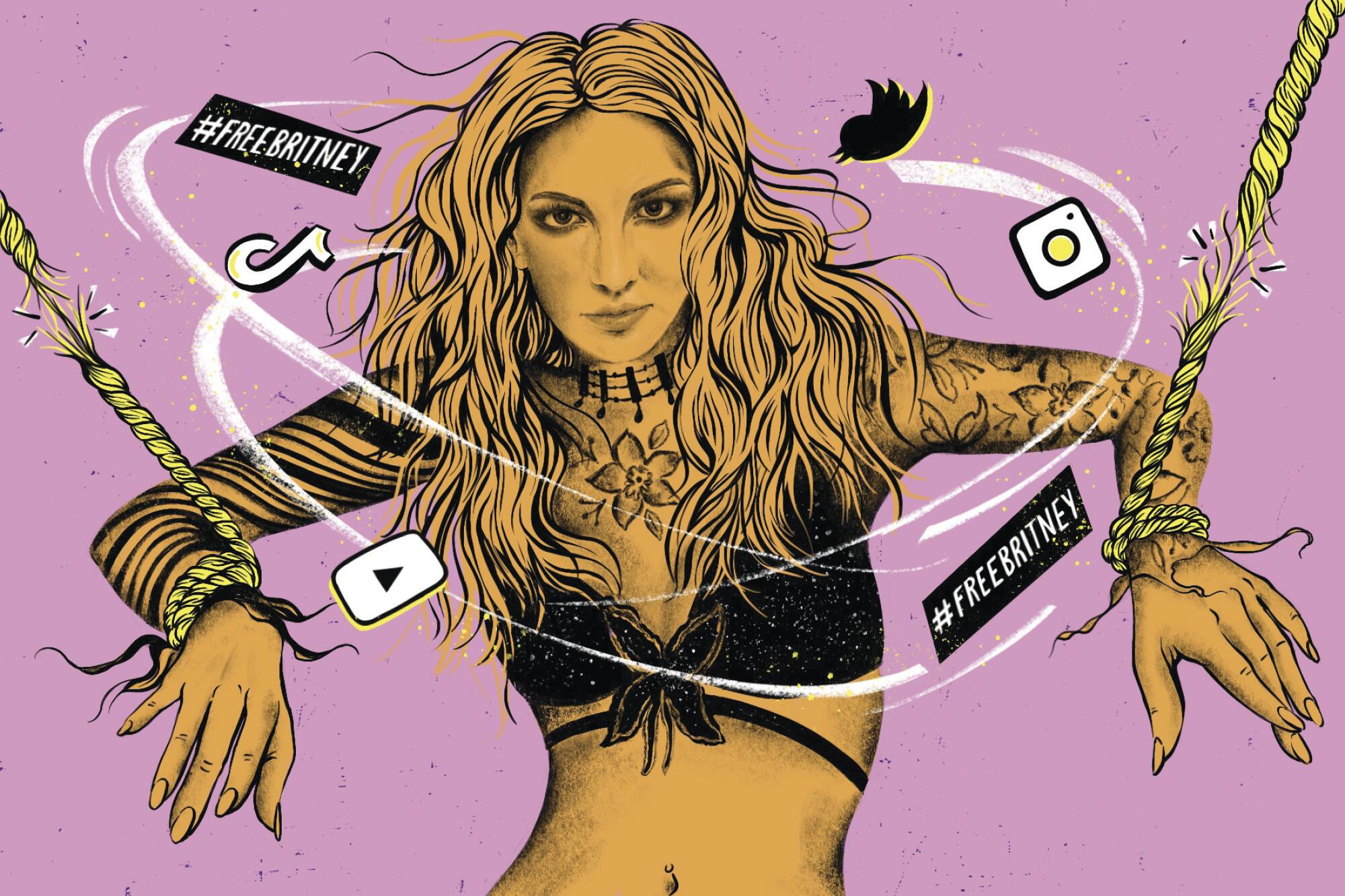
6. ‘The fight for her rights continues’
After Jamie Spears indicated his intent to step down as conservator of the singer’s estate last month, fans expressed guarded optimism that Britney was closer to reaching the freedom they’ve been advocating for more than a decade. Jamie’s filing Sept. 7 to end the conservatorship after 13 years may buoy that optimism — but as #FreeBritney advocates have long pointed out, “the fight for her rights” goes beyond his removal.
Olivas: At first I naturally got excited and screamed! Then I went through the court documents and it was like, of course Jamie is being manipulative. I do believe he will be gone eventually, but this isn’t it.
Radford: It’s also important to remember that James’ [eventual] removal does not make Britney free. The fight for her rights continues.
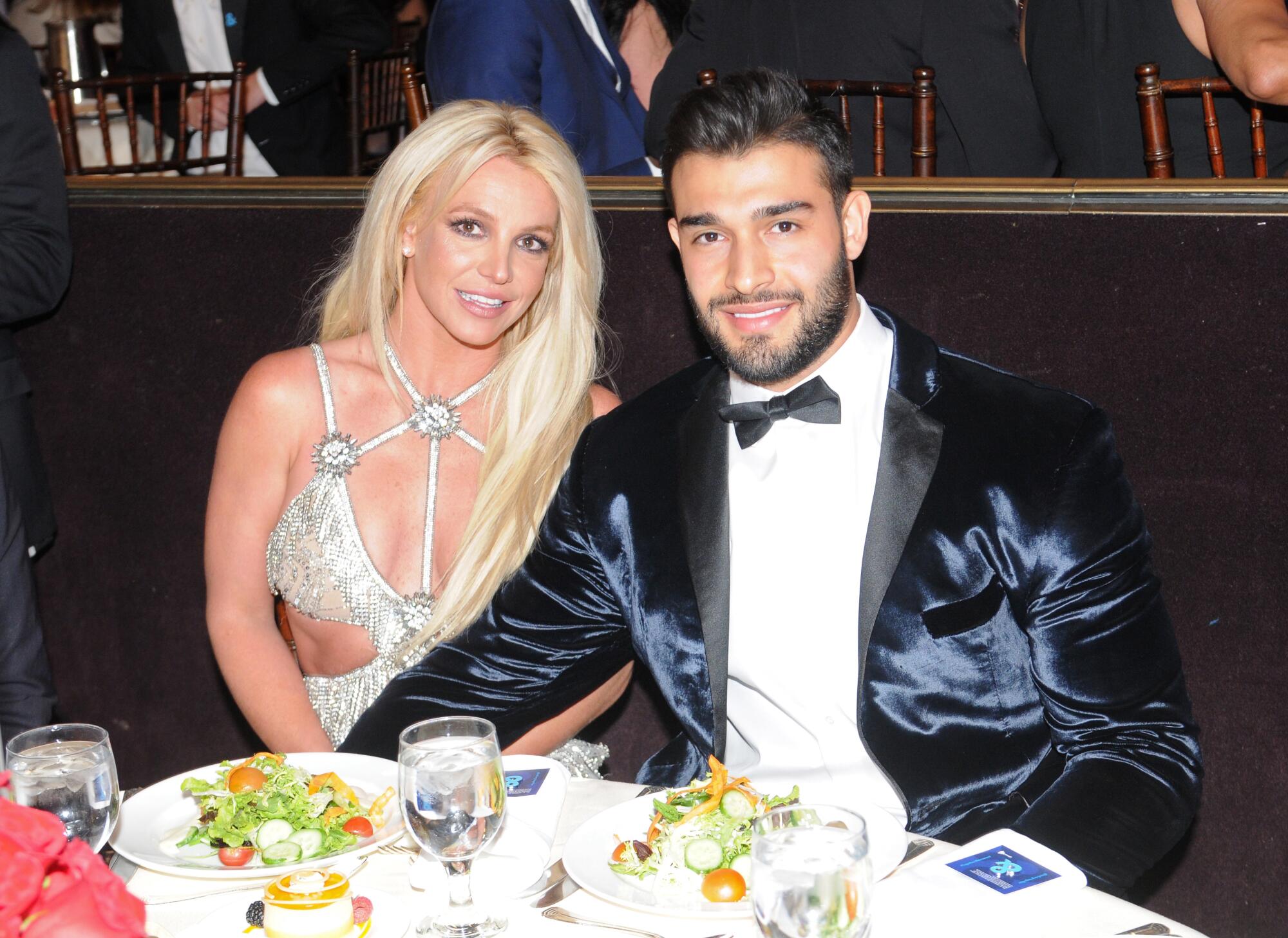
Barker: The issue of conservatorship abuse and reform is definitely the cause that I’ve taken on personally and will continue to, no matter what situation Britney’s in.
Miller: I personally welcome the end of #FreeBritney, and I don’t think that equals us stopping our support. It means that we channel our support in other ways — celebrating her music, if she decides to return to the stage, or challenging people who try to tear her down.
Vigneaux: I’ve never met these people in real life, but we feel so close. I think we’re going to miss each other. But we remember, always, that this is about Britney.
More to Read
The biggest entertainment stories
Get our big stories about Hollywood, film, television, music, arts, culture and more right in your inbox as soon as they publish.
You may occasionally receive promotional content from the Los Angeles Times.
